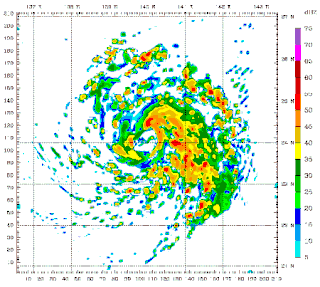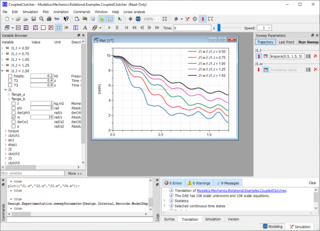Vehicle dynamics is the study of vehicle motion, e.g., how a vehicle's forward movement changes in response to driver inputs, propulsion system outputs, ambient conditions, air/surface/water conditions, etc. Vehicle dynamics is a part of engineering primarily based on classical mechanics. It may be applied for motorized vehicles, bicycles and motorcycles, aircraft, and watercraft.

Molecular dynamics (MD) is a computer simulation method for analyzing the physical movements of atoms and molecules. The atoms and molecules are allowed to interact for a fixed period of time, giving a view of the dynamic "evolution" of the system. In the most common version, the trajectories of atoms and molecules are determined by numerically solving Newton's equations of motion for a system of interacting particles, where forces between the particles and their potential energies are often calculated using interatomic potentials or molecular mechanical force fields. The method is applied mostly in chemical physics, materials science, and biophysics.

Computer simulation is the process of mathematical modelling, performed on a computer, which is designed to predict the behaviour of, or the outcome of, a real-world or physical system. The reliability of some mathematical models can be determined by comparing their results to the real-world outcomes they aim to predict. Computer simulations have become a useful tool for the mathematical modeling of many natural systems in physics, astrophysics, climatology, chemistry, biology and manufacturing, as well as human systems in economics, psychology, social science, health care and engineering. Simulation of a system is represented as the running of the system's model. It can be used to explore and gain new insights into new technology and to estimate the performance of systems too complex for analytical solutions.

A physics engine is computer software that provides an approximate simulation of certain physical systems, such as rigid body dynamics, soft body dynamics, and fluid dynamics, of use in the domains of computer graphics, video games and film (CGI). Their main uses are in video games, in which case the simulations are in real-time. The term is sometimes used more generally to describe any software system for simulating physical phenomena, such as high-performance scientific simulation.

rFactor is a computer racing simulator designed with the ability to run any type of four-wheeled vehicle from street cars to open wheel cars of any era. rFactor aimed to be the most accurate race simulator of its time. Released in November 2005, rFactor did not have much competition in this market, but it featured many technical advances in tire modeling, complex aerodynamics and a 15 degrees of freedom physics engine.
Hardware-in-the-loop (HIL) simulation, or HWIL, is a technique that is used in the development and testing of complex real-time embedded systems. HIL simulation provides an effective testing platform by adding the complexity of the process-actuator system, known as a plant, to the test platform. The complexity of the plant under control is included in testing and development by adding a mathematical representation of all related dynamic systems. These mathematical representations are referred to as the "plant simulation". The embedded system to be tested interacts with this plant simulation.
Hans Bastiaan Pacejka was an expert in vehicle system dynamics and particularly in tire dynamics, fields in which his works are now standard references. He was Professor emeritus at Delft University of Technology in Delft, Netherlands.

Dymola is a commercial modeling and simulation environment based on the open Modelica modeling language.

MapleSim is a Modelica-based, multi-domain modeling and simulation tool developed by Maplesoft. MapleSim generates model equations, runs simulations, and performs analyses using the symbolic and numeric mathematical engine of Maple. Models are created by dragging-and-dropping components from a library into a central workspace, resulting in a model that represents the physical system in a graphical form. Maplesoft began development of MapleSim partly in response to a request from Toyota to produce physical modeling tools to aid in their new model-based development process.
Vortex Studio is a simulation software platform that is developed by CM Labs Simulations. It features a real-time physics engine that simulates rigid body dynamics, collision detection, contact determination, and dynamic reactions. It also contains model import and preparation tools, an image generator, and networking tools for distributed simulation, accessed through a desktop editor via a GUI. Vortex adds accurate physical motion and interactions to objects in visual-simulation applications for operator training, mission planning, product concept validation, heavy machinery and robotics design and testing, haptics devices, immersive and virtual reality (VR) environments.

rFactor 2 is a computer racing simulator developed by Image Space Incorporated and released for Windows in 2013. Like its predecessor rFactor, rFactor2 is designed to be modified and used by professional racing teams for driver training and race car development. Much of its source code is derived from rFactor Pro, which is also used by professional racers and most of the Formula One teams and NASCAR manufacturers.

The following outline is provided as an overview of and topical guide to tires:
Cruden B.V. is a Dutch motion-based racing simulator designing and manufacturing company based in Amsterdam. Founders of Cruden have been developing professional motion simulators since the 1990s. Their experience in designing simulators for aerospace industry led them to use this knowledge to branch out into the marine, automotive and motorsport industries. Cruden is also branded as Hexatech.
Simcenter Amesim is a commercial simulation software for the modeling and analysis of multi-domain systems. It is part of systems engineering domain and falls into the mechatronic engineering field.
System-level simulation (SLS) is a collection of practical methods used in the field of systems engineering, in order to simulate, with a computer, the global behavior of large cyber-physical systems.
Marco Fainello is an Italian engineer.
In mathematics and physics, surface growth refers to models used in the dynamical study of the growth of a surface, usually by means of a stochastic differential equation of a field.

rFpro, originally rFactor Pro, is a driving simulation software used by racing teams and car manufacturers for advanced driver-assistance systems, self-driving cars and vehicle dynamics. rFactor Pro was created in 2007 as a project of a F1 racing team, using Image Space Incorporated's rFactor as a codebase. It has since been used by more F1 racing teams, top road car OEMs, Tier 1 suppliers, and motorsport manufacturers. It was originally developed for driver-in-the-Loop simulations, but has since been used for autonomous vehicle training as well. It is not licensed to consumers.

Automobilista 2 is a motorsport racing simulator game created by Reiza Studios, under the lead of Renato Simioni. The game was initially released as an Early Access title on March 31, 2020, via Steam, with the official V1.0 release taking place on June 30, 2020. Automobilista 2 features a wide variety of cars and tracks. Its main focus is on Brazilian content, which includes licensed Brazilian racing series such as Stock Car Brazil and Copa Truck. There is also an emphasis on Formula racing cars of many different eras, and includes licensed and generic vehicles. Other racing classes represented in Automobilista 2 include, but are not limited to: Retro touring cars, 1990s American open-wheel cars, GT3 and karts. Automobilista 2 supports VR, triple screen and full motion racing simulator setups.










